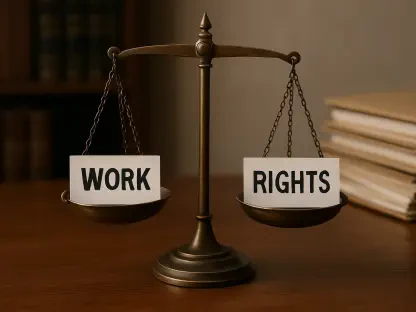The recent Supreme Court decision in For Women Scotland v. Scottish Ministers has sparked a comprehensive debate among HR professionals about the ongoing challenge of balancing workplace inclusion with legal compliance. As businesses strive to accommodate a diverse workforce, including transgender individuals, within the statutory framework of the Equality Act 2010, the ruling adds a layer of complexity to existing HR strategies. The Supreme Court’s definition of a ‘woman’ based on biological sex intersects with existing protections for transgender rights, raising critical questions about how organizations can adjust their policies to navigate this shifting legal landscape effectively. This analysis delves into the implications for HR managers and organizations, focusing on the balance between nurturing diversity, equity, and inclusion (DEI) and staying aligned with statutory mandates.
The Impact of Supreme Court Ruling on Workplace Practices
Redefining Legal Borders in the Workplace
The Supreme Court’s landmark ruling set a precedent by defining a ‘woman’ strictly according to biological sex within the ambit of the Equality Act 2010. This decision reshapes the contours of workplace inclusivity discussions, compelling organizations to reassess their approach toward sex-based provisions and facilities. Such a juridical definition could potentially realign the existing balance between safeguarding transgender rights and adhering to legal mandates on sex discrimination. HR managers now face the intricate task of revising policies to ensure compliance without marginalizing any group.
This ruling comes at a juncture where organizations are navigating an already complex array of DEI initiatives informed by evolving societal standards and expectations. By clearly delineating the legal meaning of female identity, the Supreme Court may inadvertently create an environment where rigid interpretations of sex-based rights conflict with a modern understanding of gender identity. Businesses are therefore urged to transcend mere legal compliance, fostering an inclusive culture that appreciates the spectrum of human identity while respecting the letter of the law as recently articulated.
EHRC’s Interim Guidelines: A Framework for Employers
In response to the Supreme Court ruling, the Equality and Human Rights Commission (EHRC) issued interim guidelines to steer employers through this transformative period. These guidelines serve as a provisional compass, urging employers to navigate this delicate balance of inclusivity and compliance with caution and forethought. The EHRC highlights the need to craft policies that honor the ruling’s stipulations without undermining protections against discrimination based on gender reassignment, an essential facet of the Equality Act.
The importance of structured policies that reflect the judgment while safeguarding transgender rights cannot be overlooked. As employers grapple with implementing new frameworks, they might encounter challenges in delineating sex-based rights without resorting to exclusionary measures. The EHRC’s guidelines, though temporary, act as a safeguard against hasty amendments that could engender inadvertent exclusion or discrimination. As companies strive to harmonize these competing priorities, their emphasis on policy refinement must remain steadfast, ensuring that strategic inclusivity initiatives align with the updated legal standards.
Balancing Inclusion and Compliance: HR’s Dual Mandate
Maintaining Equilibrium in an Evolving Legal Context
The equilibrium between fostering an inclusive work environment and adhering to legal mandates poses a significant challenge for HR leaders. The Supreme Court ruling imposes a responsibility on organizations to regulate workplace practices in line with the newly articulated legal parameters. Yet, this does not absolve them from their obligation to champion a nondiscriminatory ethos. As companies endeavor to synchronize inclusion goals with compliance demands, the ruling mandates a nuanced understanding of gender identity within a legal framework centered on biological sex.
Organizations must carefully assess the extent to which their policies support inclusivity while concurrently addressing the judgment’s stipulations. HR leaders are therefore called upon to navigate potential areas of tension—such as facility access and sex-specific rights—by promoting compliance alongside proactive DEI measures. Through strategic policy enhancement and sensitivity to inclusivity, companies can preserve workplace harmony while meticulously adhering to legal directives.
Advisory Roles and Legal Guidance
Guidance from advisory entities such as the CIPD and Acas emphasizes the importance of legal counsel as organizations transition to comply with the Supreme Court ruling. Until comprehensive instructions are released by the EHRC, HR leaders are advised against precipitate policy alterations that might disrupt the equilibrium between inclusion and legal compliance. Legal advisors play a pivotal role in elucidating the nuanced implications of the ruling for workplace policies, assisting HR professionals in designing inclusive strategies that seamlessly integrate compliance with transgender rights.
The intersection of legal protocols and workplace inclusivity necessitates vigilant observance of emerging trends and regulatory shifts. Consulting legal experts facilitates informed decision-making, enabling HR managers to devise consistent, legally sound practices that safeguard the dignity and rights of all employees. As organizations chart their course in the wake of the ruling, the prominence of expert legal counsel endures, ensuring that policy adaptations are judicious, balanced, and sustainable.
DEI Objectives and the Future of Workplace Inclusion
Harmonizing DEI with Legal Responsiveness
The Supreme Court’s determination concerning the legal definition of a woman reverberates through DEI frameworks, challenging organizations to align their values with statutory expectations. While legal definitions may shift, the commitment to fostering an inclusive work environment prevails. Companies are encouraged to transcend basic compliance by engaging with DEI objectives that enhance overall workplace cohesion, fostering a culture of respect and acceptance beyond statutory mandates.
The potential ramifications of enforced sex-based rights on DEI efforts cannot be overlooked. However, businesses possess the latitude to proactively champion diversity, implementing initiatives that reinforce unity and equity. Through a strategic focus on inclusion, organizations can sidestep the perceived tensions between statutory obligations and broader DEI ambitions, enriching their workplace cultures with an emphasis on inclusivity.
Risks of Over-Correction and Cautious Policy Changes
The specter of over-correction looms as companies recalibrate policies in response to the Supreme Court ruling. Hastily implemented changes risk inadvertently discriminating against transgender individuals, warranting a measured approach to policy modification. Leading HR figures, including Heather Mitchell from Browne Jacobson, caution against abrupt shifts that could marginalize employees or provoke discrimination claims, advocating instead for comprehensive, well-informed adjustments informed by the impending EHRC guidelines.
Organizations must remain vigilant to avoid the pitfalls of reactionary policy adaptation, balancing legal compliance with inclusivity. By eschewing extremes and awaiting detailed guidance, companies can refine their practices without diminishing protections for any group. This cautious yet proactive stance ensures that businesses continue their trajectory toward an authentic, equitable work environment for all employees.
Practical Implications and Future Directions
Current Steps for Employers in a Dynamic Environment
In the aftermath of the Supreme Court ruling, organizations are urged to adopt a strategy of cautious adaptation while anticipating definitive EHRC updates. During this transitional phase, employers should endeavor to clarify the legal definition of sex to employees, fostering understanding of its workplace implications. Temporarily maintaining existing policies with an emphasis on inclusivity prioritizes respect for all identities.
Inclusive facilities, such as gender-neutral restrooms, exemplify a deliberate effort to accommodate diverse employee needs without incurring discrimination claims. Employers must harness the opportunity to demonstrate a commitment to inclusivity by integrating inclusive options alongside compliance obligations, setting the stage for a harmonious workplace that celebrates diversity.
Communication and Education: HR’s Crucial Role
HR departments bear the pivotal responsibility of elucidating the Supreme Court ruling’s ramifications and articulating policy modifications transparently across organizations. Through fostering clarity and understanding among employees, HR can help avert potential misunderstandings that could arise from the reshaped legal context. Elucidating the importance of respect and equity informs internal dialogues and demonstrates a commitment to fostering an inclusive workplace.
Effective communication fosters awareness and understanding, extending beyond compliance to nurture a culture where inclusivity thrives. HR’s engagement with employees, guided by empathy and transparency, ensures seamless implementation of any policy changes, enabling organizations to adapt smoothly to the evolving landscape while preserving the dignity and rights of all staff members.
Forging a Path Forward: Navigating Organizational Change
The Supreme Court’s ruling on the definition of ‘woman’ poses a multidimensional challenge as organizations navigate legal mandates and inclusivity aspirations. HR professionals find themselves at the nexus of legal compliance and DEI goals as they steer their organizations through this period of regulatory evolution. Organizations are called upon to exhibit coherence and clarity in their strategies, while delivering workplace environments that honor both individual rights and statutory responsibilities.
As businesses wade through these complexities, their commitment to inclusivity and empathetic understanding remains vital. The concerns raised by transgender individuals regarding potential discrimination must be juxtaposed against businesses’ compliance obligations, forging a balanced pathway forward. In this fluid yet transformative landscape, businesses are tasked with evolving their policies, guided by empathy and legal comprehension, to create workplaces where all individuals can thrive with equity and dignity.
Beyond Compliance: Toward an Inclusive Future
By examining the interconnected facets of the Supreme Court ruling, organizations can identify pathways to advance inclusivity beyond mere legal adherence. The recommendation for mixed-sex facilities embodies an intentional shift towards greater accommodation and understanding, enhancing an organization’s adaptive strategy. Aligning this approach with DEI objectives allows businesses to forge an encompassing vision that transcends compliance, engendering a genuinely inclusive work culture.
As HR leaders navigate shifting legal terrain, the emphasis must remain on supporting an equitable work environment, strengthened by insightful policy evolution and informed decision-making. Organizations are poised to reconcile compliance commitments and dignity, paving the way for a future marked by inclusivity, resilience, and mutual respect.
By integrating the principles stemming from the recent ruling with strategic initiatives, HR professionals can adeptly tackle present challenges and foster enduring workplace environments that celebrate diversity and inclusion.









